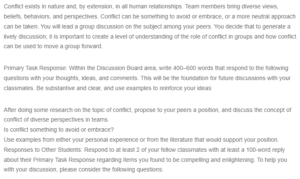Team Conflict
The Concept of Conflict of Diverse Perspectives in Teams
Today, two ongoing trends set the stage for working in organizations. Firstly, most of the work in organizations is done by teams instead of individuals working alone. Teamwork calls for a real-time combination of ideas, skills, and judgments to attain collective goals. Second, workplaces are becoming highly diverse due to global employee mobility, mergers, and acquisitions (Puck et al., 2010). As workplaces become more diverse, conflict is inevitable. Conflicts occur when members’ preferences and points of view differ, leading to disagreement on approaches to problem-solving.
Organizations that fail to manage diversity fail to benefit from the benefits presented by a diverse team. Hence, organizations must embrace a value-in-diversity management strategy to bolster team collaboration. Puck et al. (2010) describe diversity as a double-edged sword. Whereas teamwork may enhance creativity, some members may be dissatisfied and fail to identify with a group.
Conflict: Something to Embrace or Avoid?
Ashkenas & Bodell (2013) argue that humans are naturally wired to avoid conflict at work or in other social contexts. However, such a mindset is an obstacle to creative thinking and innovation. To that end, constructive conflict in the workplace is highly encouraged. Even if managers and employees try to avoid conflict, it will be an exercise in futility. That is because most workplaces are made of bright and ambitious people with controversial and different viewpoints. It is almost impossible to get along well with everyone all the time. Therefore, conflict is not something to avoid but embrace and manage.
Managers are faced with the dilemma of avoiding or embracing and managing conflict. Most tend to avoid conflict, forgetting that too much evasiveness is equally damaging (Ashkenas & Bodell, 2013). For instance, when people fail to speak about procedures and practices they do not like in the workplace, they foster the status quo. Therefore, embracing conflict and adopting the ‘not being so nice’ approach to workplace relationships is necessary.
Examples
From personal experience, conflict is something to be embraced. While working on our class group projects, one of the group members developed the habit of not wanting to contribute some money for printing. Most group members used to ignore it, and any attempt to talk about it would be considered rude. However, one of the group members confronted him about the issue. Initially, he got slightly angry but has since contributed positively toward group projects.
References
Ashkenas, R., & Bodell, L. (2013, October 16). Nice Managers Embrace Conflict, Too. Harvard Business Review. https://hbr.org/2013/10/nice-managers-embrace-conflict-too
Puck, J. F., Neyer, A. K., & Dennerlein, T. (2010). Diversity and conflict in teams: a contingency perspective. European J. Of International Management, 4(4), 417. https://doi.org/10.1504/ejim.2010.033610.
ORDER A PLAGIARISM-FREE PAPER HERE
We’ll write everything from scratch
Question
Conflict exists in nature and, by extension, in all human relationships. Team members bring diverse views, beliefs, behaviors, and perspectives. Conflict can be avoided or embraced, or a more neutral approach can be taken. You will lead a group discussion on the subject among your peers. You decide that to generate a lively discussion; it is important to create a level of understanding of the role of conflict in groups and how conflict can be used to move a group forward.

Team Conflict
Primary Task Response: Within the Discussion Board area, write 400–600 words that respond to the following questions with your thoughts, ideas, and comments. This will be the foundation for future discussions with your classmates. Be substantive and clear, and use examples to reinforce your ideas:
After researching the topic of conflict, propose to your peers a position, and discuss the concept of conflict of diverse perspectives in teams.
Is conflict something to avoid or embrace?
Use examples from your personal experience or the literature that would support your position.
Responses to Other Students: Respond to at least 2 of your classmates with at least a 100-word reply about their Primary Task Response regarding items you found compelling and enlightening. To help you with your discussion, please consider the following questions:

